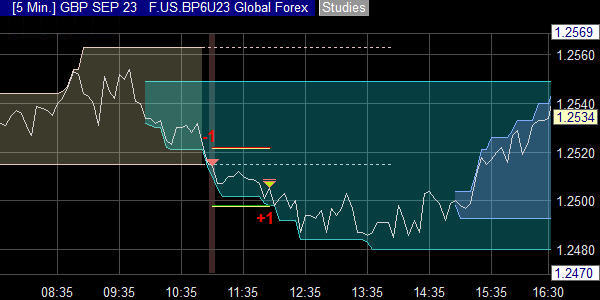Great Ideas On Selecting Forex Trading Sites
Great Ideas On Selecting Forex Trading Sites
Blog Article
Top 10 Risk Management Tips When Trading Forex Online
Forex trading success is dependent on the management of risk. Here are the top 10 strategies for managing risk to protect your trading capital and minimize potential losses.
Make Stop Loss orders in every Trade
1. Stop-loss contracts close automatically when the value of the market is at certain levels, thereby restricting losses. Set a stop loss to make sure you don't risk more than you can afford should the trade goes against you. Always put a stop-loss in place immediately when you open a trade.
2. Define Risk per Trade
Limit the amount you risk for each trade, which is usually set not to exceed 1-2 percentage of your account balance. This lets you stay on the market when you are on losing streaks, and prevents major losses to your account from one trade.
3. Use Proper Position Sizing
The size of your account is the amount you purchase or sell in an exchange. You can adjust the size of your position based on the size of your trading account, the risks of your trade, and your limit loss. As an example, if the stop-loss distance is higher than your account size, you should reduce the position size to ensure a steady amount of risk.
4. Avoid Over-Leveraging
The use of high leverage can increase profits and losses. Although brokers may offer high-leverage options for beginners, they should stick to low leverage. You could be able to lose your entire account when you leverage too much, which is why it is recommended to start with the lowest leverage (1 to 10 or less) until you've gained experience.
5. Diversify Your Trades
Don't invest all your capital in a single trading or pair. Diversifying the timeframes and trading pairs helps reduce losses from unexpected market events. To avoid losing your focus, diversifying too much can cause you to lose focus and divert your attention.
6. Implement the Trading Plan with Risk Limitations
A trading plan that has clear rules for entry departure, entry and risk tolerance can assist you in keeping your sanity. Set weekly or daily limit on your risk, like not putting your money at risk by more than 5percent of your account each day. When you reach your risk limit, stop trading and take a moment to consider it.
7. Use trailing stop to lock in profits
A trailing stop is an evolving stop-loss which adjusts when the market moves in your favor. This allows you to capture profit if the market goes down while giving your trade room to grow when it's moving in the direction of profit. This is a fantastic way to safeguard your profit without having to shut down the trade too early.
8. Stay in control of your emotions and avoid revenge trading
These emotional trades could cause you to make poor decisions and take excessive risks. Anger, fear, or greed may cause traders to trade in a hurry or take more risks than you anticipated. Beware of "revenge trades" after a loss or attempting to recover the losses you suffered in one transaction. Stay with your strategy and limit risk to prevent increasing losses.
9. Avoid Trading During High-Impact News Events
Extreme market volatility could result from high-impact events such as announcements from central banks or economic reports. If you have no experience trading news, it is best to stay clear of trading or closing positions prior to and after major announcements. The price spikes may lead to unexpected loss.
10. Keep a Trading Journal to analyze mistakes
You can learn a lot from your losing and winning trades if you keep a journal. Keep track of the details of each trade, including the reason you made the trade, the risk, placement of your stop loss and the outcome. By periodically reviewing your journal you will notice patterns in your mistakes or success. This will help you to enhance your risk management.
Forex trading risk management is just as crucial as identifying profitable opportunities. Use these guidelines to safeguard your investment capital, minimize losses and devise a long-term approach. Follow the recommended https://th.roboforex.com/ for website tips including fx trade, forex best trading app, forex brokers usa, foreign exchange trading platform, broker cfd, forex brokers usa, platform for trading forex, app forex trading, currency trading platforms, forexcom and more. 
Top 10 Leverage Understanding And Use Tips When Considering Forex Trading Online
Leverage can be an effective instrument in Forex trading, increasing the potential for profits as well as losses. Here are 10 tips to help you understand how to leverage your investments effectively.
1. Learning the fundamentals of leverage
Leverage allows you to control an even greater amount than your actual capital is. As an example the leverage ratio of 1:100 means you have control over $100 on the market for every dollar in your account. This means that any change in the market could affect your account balance through this exact factor. It can therefore increase both gains as well as losses.
2. Be aware of the dangers of high leverage
The higher leverage increases both profit and loss. With a ratio of 1:500 for example, the risk of a 0.2 percent price change could erase the entirety of your investment. The high leverage appeals for many traders who are just beginning their journey but it can lead to substantial losses if not vigilant.
3. Start with Low Leverage
If you're new to Forex trading, it is ideal to begin with an leverage ratio of 1:10 or 1:20--especially if this is your first time. This lets you manage your losses and gain confidence and reduce the risk of losing a large amount of your capital.
4. Calculate the Margin needed
In order to leverage a position, you will need to have a set amount of money in your account. For instance the $10,000 transaction needs just $100 in margin when leveraged 1:100. You must understand these requirements in order to avoid being liquidated or having your trade canceled.
5. Leverage is an excellent instrument to be used to complement your trading strategies.
The trading of high-frequency and short-term duration may gain from moderately leveraged thanks to the tighter stop-loss placement. As long-term positions are often held throughout more significant price changes, they may benefit from a minimal amount of leverage. You can tailor leverage to each trade based on the timeframe of the trade and its goal.
6. Make Strict stop-loss order on each trade
Stop-loss limits your loss when you're in a leveraged situation. This helps protect your capital if the market moves to the downside. Because leverage can increase losses, you should limit your stop-loss to the level that is accordance with your tolerance to risk. This prevents losses from spiraling out of control.
7. Monitor Your Leverage Ratio Regularly
When your balance fluctuates, your leverage ratio may also change. Be sure to keep an eye on your positions regularly to avoid accidentally over-leveraging. The reduction or closure of certain trades can help maintain an acceptable leverage ratio.
8. Use a Leverage or Margin Calculator
Many brokers provide margin calculators and tools to assist you in determining the amount of leverage being employed, and the margin needed for the particular trade. These tools will help you better understand the leverage you're using and the margin required for trading.
9. Be Aware of Leverage Restrictions by Region
Leverage caps are set by various regions, based on their regulatory guidelines. Retail traders in America are limited to leverage ratios of 1:50. In Europe, the maximum leverage on major currencies pair is 1:3. Choose a leverage ratio that is within the legal limit to reduce risk and ensure the compliance.
10. Re-evaluate Leverage based on the current market conditions
Market conditions may change rapidly and alter the risk profiles of investments that leverage. If you trade in volatile market conditions, or during high-impact news releases and announcements, reduce your leverage. If the market is uncertain, reducing leverage could aid in protecting against sudden and sudden price fluctuations.
In the end, when evaluating leverage, it is important to be aware of both the benefits and dangers. By using it responsibly and creating protective stop-loss guidelines and selecting the proper leverage ratio you will be able to profit from the benefits while minimizing the risks. View the top rated for website advice including best broker for currency trading, forex app trading, best broker for currency trading, united states forex brokers, 4x trading, forex exchange platform, forex broker, forex trading strategies, best currency brokers, fbs review and more.
Top 10 Trading Platform And Technology Tips When You Are Thinking About Online Forex Trading
1. Forex trading is a complex business. Knowing the latest technology and deciding on the most suitable trading platform is crucial. These are the top ten suggestions for using technology to enhance trading and navigate through trading platforms.
Select a platform that's user-friendly
Select a platform that is easy to navigate and intuitive. You should be able to quickly access charts, manage positions, and make orders with no confusion. MetaTrader 4 and MetaTrader 5.
2. Make sure you have a strong internet connection
Trading in Forex requires reliable Internet access. An unstable or slow internet connection can lead to delays, missed opportunities, and delays with order execution. You should consider upgrading your internet connection or making use of the Virtual Private Server to ensure the stability and reliability of your connection if you have frequent connectivity issues.
3. Speed of Test Order Execution
The speed of execution of orders is vital, particularly if you are day trading or scalping. A platform with quick execution times will reduce slippage. This ensures you are in a position to trade and withdraw trades at prices you have established. Try out the platform with a demo account before making the move to a live account.
4. Explore Charting and Analysis Tools
A reliable platform must provide advanced charts indicators as well as technical analysis tools. Choose a platform that lets you personalize your charts and provide access to a variety of indicators. They should also permit detailed technical analysis. This allows you to make better informed decisions when trading.
5. Make sure you are able to trade on mobile devices.
Mobile trading applications allow users to monitor and manage trades while on the move. Make sure the app on your mobile comes with all the essential features including trading, charting and monitoring of accounts.
6. Automated Trading Options
Many traders make use of automated trading algorithms or trading systems to improve the consistency of their trading and decrease manual effort. If you are interested in automation choose a platform that supports experts or trading robots. The MT4/MT5 platform is compatible with a range of automated trading software.
7. Verify the security features
Security is crucial in online trading. Choose a platform that has encryption protocols, 2-factor authentication (copyright), or other security features to safeguard your data and funds. Platforms that do not have strong security may be vulnerable to cyber-attacks.
8. Find out about real-time data and News Feeds
In order to make the best trading decisions it is crucial to receive real-time updates on price and economic news. A good platform offers precise, up-to date market data and news feeds from trusted sources. You will be kept informed of news that affect the market and could affect your trading.
9. Examine compatibility with Your trading style
Different platforms suit different trading styles. Platforms with rapid execution and single click trading are ideal for scalpers. Platforms that have advanced charts and analytical tools are best suited for trading swing traders. Be sure that the platform you choose matches your trading style.
10. Test Customer Support & Platform Reliability
A reliable customer support service is essential, especially when you are experiencing issues with your platform or require technical assistance. By asking questions, you will be able to test the team's expertise and ability to respond. Examine the stability of the platform and uptime. A frequent crash or interruption can affect the performance of your trading.
When you choose a trading platform that is compatible with your needs and knowing the technical details to improve your trading performance and better prepare yourself to manage the market. Make sure you prioritize usability, as well as security, and use specific tools to help your trading. View the top https://th.roboforex.com/about/activity/awards/ for site examples including forex trading strategies, regulated forex brokers, trader fx, forex broker, forex brokers list, good forex trading platforms, forex exchange platform, forex brokers list, forex broker platform, best currency trading app and more.